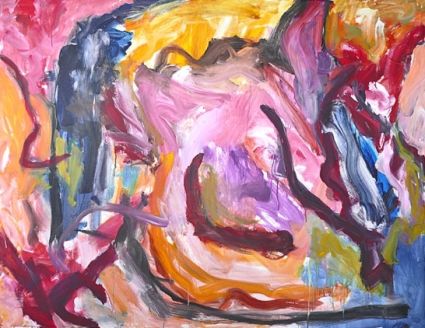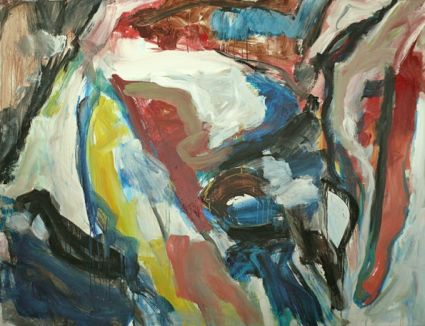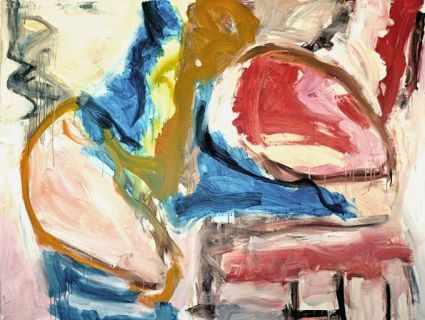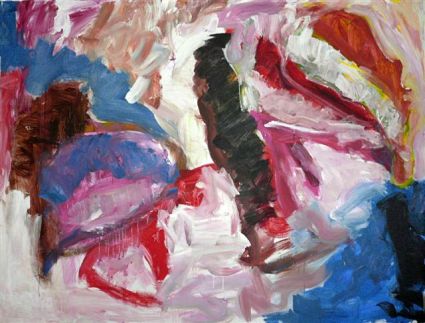COLLECTION
PAINTINGS
recent
from 2005/06 - present
old
from 1993 till 1999
from 2000 till 2005/06
OBJECTS
booklets
ceramic work
FOTOGRAPHY
PRINT VERSION
acryl on paper | acryl on canvas | banners | oil on canvas | benfo Benfo is the name of the cooperation between the artists Ben Vollers and Fons Heijnsbroek. Benfo, a ‘Dialogue in paint’It was in 2006 that Ben Vollers en Fons Heijnsbroek started to paint together for the first time as a serious joke. Same spot, same moment, on the same canvas, for a public on Sunday afternoon in the park. The two artists already knew one another for 15 years, but this was the first time they started to paint together physically. What started out as a one-day-stand performance grew, during the next years, into a rather unusual but intensive dialogue with paint between the two abstract artists. It resulted in 2008 and 2009 in 40 large abstract paintings that they had painted together. In doing so they developed a great deal of confidence and freedom in their duo painting.
Another common ground for their cooperation is that they are searching for all kinds of possibilities to incorporate the unknown, unexpected and unpredictable into their personal art. That’s why in practicing their duo-painting, there is a similarity to discover what the one means to the other during their common painting process. In a mutual sense they are the unknown/unpredictable for the other. Every moment during the painting process the direction of the painting is uncertain, because of the unpredictable other, who is able to change the whole painting in just a few seconds, and this without asking permission first or a verbal warning! It really does happen and is sometimes hard for the other to accept. But during the years they have learned to appreciate this unknown, because both artists accept that they are dependent on the other’s unpredictable powers. That is why the painting itself becomes the area of communicating, in picture language, this mutual dependency and dynamic: to ask for or to define, to make statements or withdraw them, to argue, to destroy if necessary, or to affirm what already exists on the canvas. The definite image of the painting is only certain when both artists agree the painting is really finished.
Ben Vollers and Fons Heijnsbroek are Dutch, contemporary abstract painters, so they are familiar with the damp atmosphere and the natural light. It was a challenge to them to capture the French atmosphere during the spring of 2009, in and around the river Le Cousin with all its floating images reflected in the water. This they did by rebuilding the atmosphere in their spontaneous paintings, and by using the French landscape in spring as a source of their own visual imagination. The collection of work they painted together in Avallon in the old Catholic St.Pierre church has been shown in another church, this time Protestant in Amsterdam, De Oosterkerk, during the month of February 2010. Interview with Benfo, 2009 * There is a great similarity between you two painting together and jam sessions in Jazz. Is that what you are doing when you paint together- spontaneous jazz in paint? What we do is improvise on one canvas: not particularly on an existing theme, and not one at a time, but together, on the spot, we continuously react to one another with brush and paint. We do not have a concept beforehand, no theme; we start totally blanco. But, we do have one another’s input to react to. For instance, Ben makes a line and Fons takes it further, or puts down another line or changes the colour etc. Apparently we understand each other’s way of working. Jam sessions in Jazz are very much here and now, reacting on the spot, the question, the answer; that’s very similar to what we do with paint. One starts an idea and the other can react. * Jazz musicians often have a standard as the basis for a jam session, what about you two?
* What do you have in common in painting? Something we have in common in our individual painting is that neither of us make a preliminary sketch. We both paint directly onto canvas/paper and react to that whilst painting. When we work together as Benfo, we offer one another images that the other can react to in an associative way. We both experience that this way things happen on canvas that we would never have made individually. The other is necessary in order to extract yourself from individual shortcomings in your own imagery. It can only be done in acrylic paint, a paint that is direct and dries quickly, so can be painted over easily. * What aspects are of great importance in the process of painting together? Apart from the spontaneity and the interaction to one another, there is the aspect of consciously constructing and destructing and consideration/thought. Considering whether the painting will make it, whether it will meet the promise of possibilities or intentions. At that moment we both feel that something is possible, that the painting could turn out well, but we’re not there yet! It’s the moment the painting tells us something and, it’s up to us both to understand. The painting has it’s own life, it has come to life through us and now it demands that we do this or that. Often, we have to let it go for a bit – distance ourselves in order to recognize the question. We both know there is a moment when we have to paint carefully, with consideration. The phase of associative painting, wildly, is over - which is by the way just as important. Our painting is a construction, in the sense that there must be cohesion and the various parts must work towards a whole. A structure, let’s say architecture, balance, contrast. In between all that is our freedom; but the final painting must be more than that. Otherwise it’s a failure. * What does Ben do that Fons would never do? Ben puts down areas/space, almost automatically. Fons nearly always starts with a construction in lines. Ben paints his spaces/areas with strokes, mainly in white or black, with further strokes so they don’t cover the canvas completely; his lines are often zigzag. Fons’ lines are often flowing and more organic. He often puts coloured layers over something already present, so the colour of that particular area is changed. Fons uses the colours yellow/green/violet/purple more often and Ben more often uses black/sienna but also yellow, dark blue and often lots and lots of red. But all that was six months ago and is probably old hat. In that respect we consume one another! * What about trust?
* What are your criteria for a painting to be a success or not? We each have the conviction that a painting should be more than pleasing or nicely painted. We both see that we want to go further. There is no embarrassment between us when trying out something unusual; we can put down something impulsively without worrying about what the other thinks of it. There has to be some risk, otherwise the painting would be a failure for us anyway. * What is your position in present day abstract painting? A great deal of what we see around us makes us think that abstract painting is too slick, with too much emphasis on a ‘pleasing’ abstract painting. We are on the wilder side of abstract painting. It seems that we think that an interesting painting can’t be slick. As a viewer you have to make an effort to get into the painting, plough your way through. On the other hand, we offer a painting that one can actually get into with one’s eyes; we are offering a serious visual image. A slick painting excludes; there is no opening, no entrance. We want a painting to have its own ‘inside’. That’s what we mean by a painting being finished; there must be an ‘inside’ apparent in the painting; the painting has the right to existence because it gives visual form to that ‘inside’. * What, from life itself, influences you both? We are both passionate city people. We see the modern phenomena of the city; adverts, light reflections, transparency; but also the underground (metro) building, modern building constructions, people packed together. We don’t live in a world city, Amsterdam is small and has an old city centre with an old structure, where we both live. So, Amsterdam has both old and new, the city changes through different time layers. That fact fascinates us both, we feel our connection through that. We both accept without doubt that the city is an organism, continually changing and innovating. We both enjoy the ensuing expression of this. From art painting point of view it is impossible to see all the phenomena and put them I a painting, giving them a second visual existence. That’s our naturalistic side; we put real phenomena and impressions in our paintings. |
| top |
 Ben Vollers’ and Fons Heijnsbroek’s personal art is abstract and expressive. Both painters like to use their direct visual impulses entering into the paintings. This is probably the basis for their cooperation. Besides which, both artists had loved abstract expressionistic painting for decades, which is why they discussed together the former painters who gave shape to this abstract area in modern painting. Both artists also share their love of the city of Amsterdam and its modern visual dynamics, and both love free jazz.
Ben Vollers’ and Fons Heijnsbroek’s personal art is abstract and expressive. Both painters like to use their direct visual impulses entering into the paintings. This is probably the basis for their cooperation. Besides which, both artists had loved abstract expressionistic painting for decades, which is why they discussed together the former painters who gave shape to this abstract area in modern painting. Both artists also share their love of the city of Amsterdam and its modern visual dynamics, and both love free jazz. In Avallon (Burgondy, France) in the spring of 2009, the two had their first big show of 25 Benfo paintings, made together during the last two years. This show took place in the medieval Roman church St.Pierre. The other part of the show was that both artists made a lot of new Benfo paintings on the spot; for a whole month the old St.Pierre church with its Romanesque sculptures was their studio, and the public could watch them working and painting together. That is how a second collection of Benfo paintings came about, with its main theme the river Le Cousin with its borders, flowing past the city of Avallon. Vollers and Heijnsbroek experienced the painting intensely there, painting in a much broader and older tradition, like Sam Francis and Joan Mitchell did decades before. Both were abstract expressionist American artists, but nevertheless, strongly fascinated by the Water Lilies paintings by the impressionist French painter Claude Monet. Both artists decided, after World War II, to go to France for years to work in the same place in the same landscape as Monet.
In Avallon (Burgondy, France) in the spring of 2009, the two had their first big show of 25 Benfo paintings, made together during the last two years. This show took place in the medieval Roman church St.Pierre. The other part of the show was that both artists made a lot of new Benfo paintings on the spot; for a whole month the old St.Pierre church with its Romanesque sculptures was their studio, and the public could watch them working and painting together. That is how a second collection of Benfo paintings came about, with its main theme the river Le Cousin with its borders, flowing past the city of Avallon. Vollers and Heijnsbroek experienced the painting intensely there, painting in a much broader and older tradition, like Sam Francis and Joan Mitchell did decades before. Both were abstract expressionist American artists, but nevertheless, strongly fascinated by the Water Lilies paintings by the impressionist French painter Claude Monet. Both artists decided, after World War II, to go to France for years to work in the same place in the same landscape as Monet.  We’ve got all sorts of stuff in our heads, amongst other things the art of painting and the images of that. In that way we are also similar to Jazz musicians jamming. They use previous jazz. They improvise on an already existing, well known number, a standard, that every well versed jazz musician knows. In the same way we are familiar with abstract expressionism, but also with painting expressively and landscapes, we write and talk about the art of painting without turning it into a concept!!! What are our standards? Well, not only the famous toppers within abstract expressionism. But we have them in mind. But also the city, the light, Van Gogh, Soutine, Ruysdael, Corot, Guston etc.
We’ve got all sorts of stuff in our heads, amongst other things the art of painting and the images of that. In that way we are also similar to Jazz musicians jamming. They use previous jazz. They improvise on an already existing, well known number, a standard, that every well versed jazz musician knows. In the same way we are familiar with abstract expressionism, but also with painting expressively and landscapes, we write and talk about the art of painting without turning it into a concept!!! What are our standards? Well, not only the famous toppers within abstract expressionism. But we have them in mind. But also the city, the light, Van Gogh, Soutine, Ruysdael, Corot, Guston etc. Painting Benfo paintings can only be done because there is mutual trust. Both in the ability in the art of painting as in the judgement. We also know that the ‘one’ is not trying to paint out the other, or trying to dominate in some way. There is a dynamic equality of input. There is also the trust that when ‘one’ reaches an impasse he can let the ‘other’ carry on to keep the process moving, to pull us both our of the impasse.
Painting Benfo paintings can only be done because there is mutual trust. Both in the ability in the art of painting as in the judgement. We also know that the ‘one’ is not trying to paint out the other, or trying to dominate in some way. There is a dynamic equality of input. There is also the trust that when ‘one’ reaches an impasse he can let the ‘other’ carry on to keep the process moving, to pull us both our of the impasse.